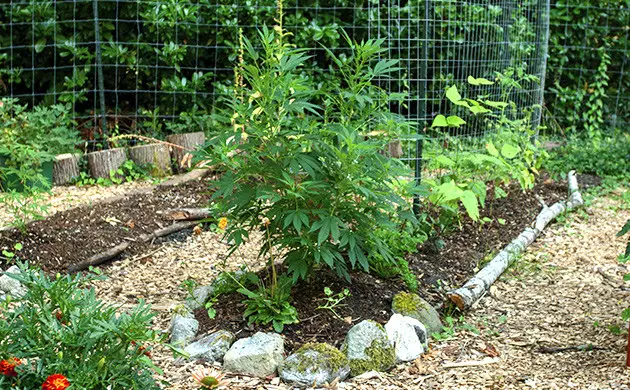How to Grow Weed on a Budget: Thrifty Tips for Indoor and Outdoor Gardens

You've probably heard that growing your own weed can be a pricey endeavor, but fear not. With a little creativity, know-how, and determination, you can grow some green without spending too much green.
So, whether you have an indoor setup or a sprawling outdoor garden, we’ve got some nuggets of wisdom for you. Our fellow growers have shared with us their tried-and-tested tips for growing weed indoors and outdoors on a budget.
How Much Does It Cost to Grow Weed?
Before we dive into all the tips and tricks for growing cannabis on a budget, let's take a moment to crunch some numbers and see if the effort is worth the investment.
For those looking to grow indoors, the initial investment is typically a few hundred bucks. A basic grow tent can cost up to $100 or less, while a small grow light might set you back around $50. Add in seeds, soil, fertilizer, containers, and fans, and you can get started with an indoor grow for about $300. Plus, don't forget about electric bills, which depend on the wattage and running time of your equipment as well as the cost of electricity in your area.
On the other hand, the startup costs of an outdoor garden tend to be much lower. You can skip most of the equipment needed for an indoor setup and start your outdoor grow for under $50.
Remember, these figures are just rough estimates for getting started. With a little ingenuity, you can save even more by building parts yourself or repurposing materials.
How to Grow Weed Indoors on a Budget

Indoor growing has its perks, like the ability to cultivate your crops all year round, but it can also be a bit pricey. If you want to keep the costs low and yourself high, read on to learn how to grow weed on the cheap indoors.
Set Up a Budget Grow Room
A grow room will be the priciest item on your list. Starting up an indoor grow room can cost as much as $75 per square foot, as opposed to $50/square foot for greenhouses and $10-$17/square foot for outdoor gardens.
If you’re planning to grow just a few plants, an indoor tent will suffice. The cheapest ready-made grow tents start from around $50, while high-end options with top-quality components can cost over $1,000. However, if you decide to cut corners by using cheap materials, you can build a DIY tent for just $2-5!
Growing many plants at a time requires more space. Transform your closet, garage, or spare room into a grow paradise. Use reflective material like Mylar or even aluminum foil on the walls to bounce light around your plants, giving them the light they need. Just in case, we’ve got some tips for setting up an indoor grow room without stretching your budget.
Use LEDs
If you're trying to keep costs down, we recommend investing in a quality LED lighting panel. Although LEDs might cost more outright than HPS lights, their energy efficiency and lower operating costs make them a smarter choice in the long term. Plus, LEDs run much cooler, which is a key factor if you're working with limited space, as most budget growers do.
If high electricity bills are an issue, consider scaling down your grow. Opt for a small tent with an efficient light source. For example, you can use a 150W LED for a single plant in a 60x60 cm tent. This is more cost-effective than using a larger tent with a more powerful light. Aim to match your power output with the number of plants you grow.
Buy the Right Fan(s)
Never skimp on ventilation in your grow room, no matter your budget. Extractor fans help remove stale air and unwanted odors, while oscillating fans maintain air circulation, which helps strengthen the stems of your plants and reduces the risk of pests or plagues invading your crop.
Choose an extractor fan with the right m³/h (cubic meter per hour) rating for optimal air circulation. Aim for a fan with an m³/h 70 times higher than your grow space volume. For example, if your tent measures 1m x 1m x 2m (2 m³), invest in a fan with at least 140 m³/h. The smaller the extractor fan that effectively maintains the optimal temps, the less power it'll use, saving you money.
Keep the Temperatures in Check
To maintain a budget-friendly grow, keep temperatures and humidity in check. Using small oscillating fans helps circulate air and prevent heat buildup. If you’re in a hot area, consider running grow lights at night.
Cannabis plants prefer temperatures of 23-28°C and 60-70% relative humidity. Keep temperatures low (without stunting growth) to save money over the course of several months.
Choose the Right Growing Medium
When it comes to choosing the right growing medium for your budget-friendly grow room, soil is the clear winner. You can also make your own super soil to save even more money.
Organic fertilizers can help you cut costs over time. Firstly, it's nearly impossible to overfeed plants with organic. Secondly, organic fertilizers don’t leave salt deposits in the soil. Thirdly, organic nutrients promote healthy microbial life in the soil and protect plants from pests and pathogens.
Lastly, you can make them on your own – from molasses, compost tea, bat guano, banana peels, egg shells, fish emulsion, worm castings, you name it!
Reuse and Repurpose
Reuse your soil and growing containers. To give old soil a new life, try amending it with homemade compost or other organic matter. You can also make or repurpose your own containers by using items like 5-gallon buckets or large storage bins. It's eco-friendly, and your plants won't judge you for being thrifty.
Instead of buying additional gardening tools, sterilize your gear before using it again. This helps prevent pest and disease transfer between cannabis and other plants, saving you money without compromising your crops’ health.
Clone Instead of Buying Seeds
The cost of seeds will add up with each harvest, so if you've got a favorite strain or plant, take some cuttings and start new plants for free. It's a money-saving technique that's been used by frugal ganja gardeners for years.
Cloning requires a healthy mother plant, space, an 18/6 light cycle, and plenty of fertilizer, but it lets you take multiple clones for years to come. However, mother plants' yield potential decreases over time. Renew mother plants every 6-12 months to maintain healthy clones – buy seeds, select the healthiest plant as a mother, and clone it for 6 months.
How to Grow Weed Outdoors on a Budget

Now that we've covered the essentials of indoor growing on a budget, it's time to step outside and bask in the natural sunlight! Outdoor growing can be even more cost-effective, as you get to harness the power of nature. Let's explore how to grow weed on the cheap outdoors.
Choose Your Spot Wisely
Picking the right spot for your outdoor grow is key. Choose a location that gets plenty of sunlight, has access to water, and provides some protection from the elements (such as strong winds or heavy rain). You'll save time, money, and energy, allowing you to focus on other important aspects of your grow.
For young plants, pick a spot with morning and early afternoon sun but shaded from midday sun. As they mature, gradually expose them to more sunlight – around 12 hours a day if possible. Bring top-heavy or flowering plants indoors during storms to prevent damage or exposure to high humidity.
Go Organic
Growing organic cannabis is easier outdoors than indoors. Outdoors, planting cannabis directly into the ground allows your plants to develop an extensive root system and access naturally rich soil. Good rainfall during the growing season can also help save on watering costs.
Most outdoor growers use pots for controlled growth and mobility, but organic fertilizers can be cost-effective. Choose the same organic fertilizers we talked about above or create your own from compost or compost tea made from fruit peels and vegetable scraps, which can be more affordable than synthetic nutrients.
Use Local Resources
It’s good to use local resources like free compost, wood chips, or even horse manure (just make sure it's well-rotted!). Many cities and garden centers offer these resources for free or at a low cost. Not only will you save cash, but you’ll also be helping the environment by reducing waste.
Try Companion Planting
Plant your cannabis alongside other complementary plants to naturally ward off pests and enhance your crop's growth. Good companions for cannabis include basil, marigold, and peppermint. These plants will help protect your buds from unwanted pests while also creating a beautiful and diverse garden space.
Train Your Plants
Showing your plants some tough love won’t actually save you money, but it will get you more bud for the money you already put in. Use plant training techniques like LST or topping to increase your plants’ yields without spending a dime.
This tip also works well for indoor grows, where we recommend using the Sea of Green (SOG) technique. Growing multiple small plants (from seed or clone) in close proximity is often quicker and less labor-intensive than growing fewer, larger plants with methods like LST or topping.
Choose Autos
Autoflowering strains are perfect for outdoor grows since they’re tough and resilient. This is especially important if your climate isn’t weed-friendly. What’s more, autos have a quick growth cycle, allowing you to harvest two or even three crops over the summer using the same pots and soil. This cost-effective approach lets you see more bang for (almost) the same buck.
Grow in Hay
This method is especially convenient if you live in a rural area, where hay bales can often be found for free or at a very low cost. To grow in hay, create a cavity in the center of the bale, fill it with soil, and plant your cannabis. The hay encasing retains moisture and gradually decomposes, providing nutrients to your plants. By using hay bales, you can save on both pots and fertilizer.
These were our tips to grow weed on a budget – put them to good use to draw in your horns without compromising on the quality of your harvest. Hope this helps!
Herbies Head Shop expressly refuses to support the use, production, or supply of illegal substances. For more details read our Legal Disclaimer.












Thank you for leaving a comment for us!
Your feedback will be posted shortly after our moderator checks it.
Please note that we don’t publish reviews that: